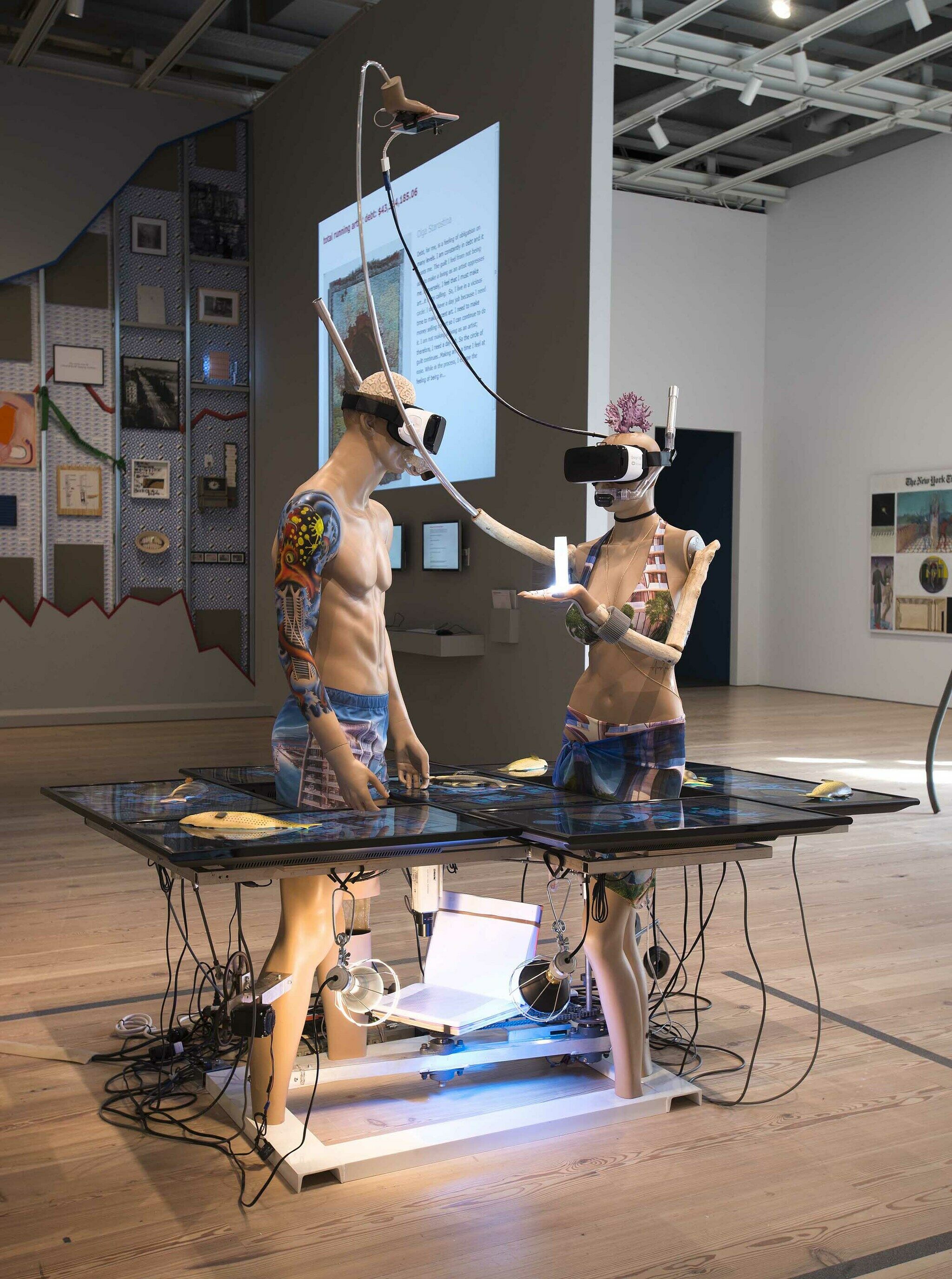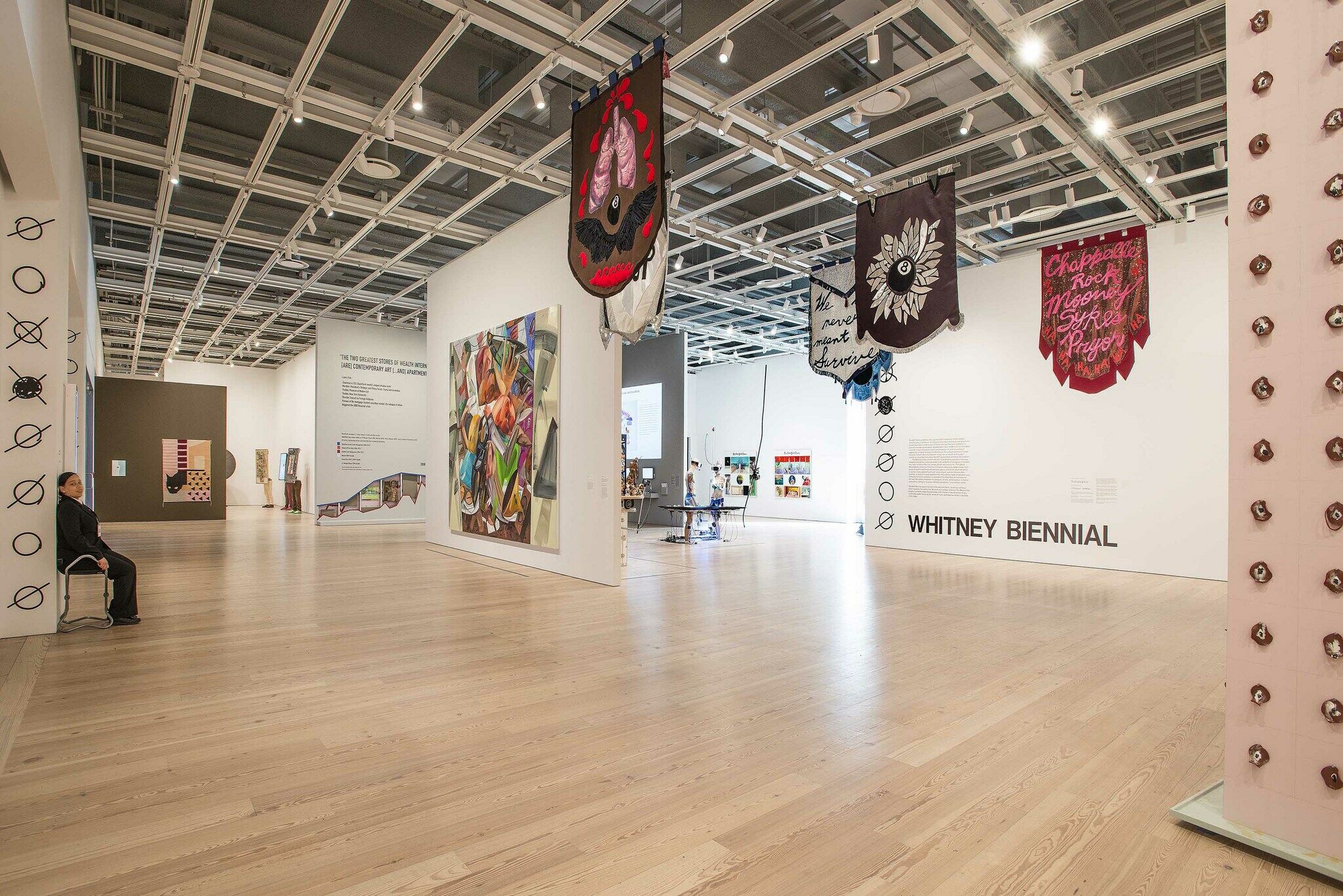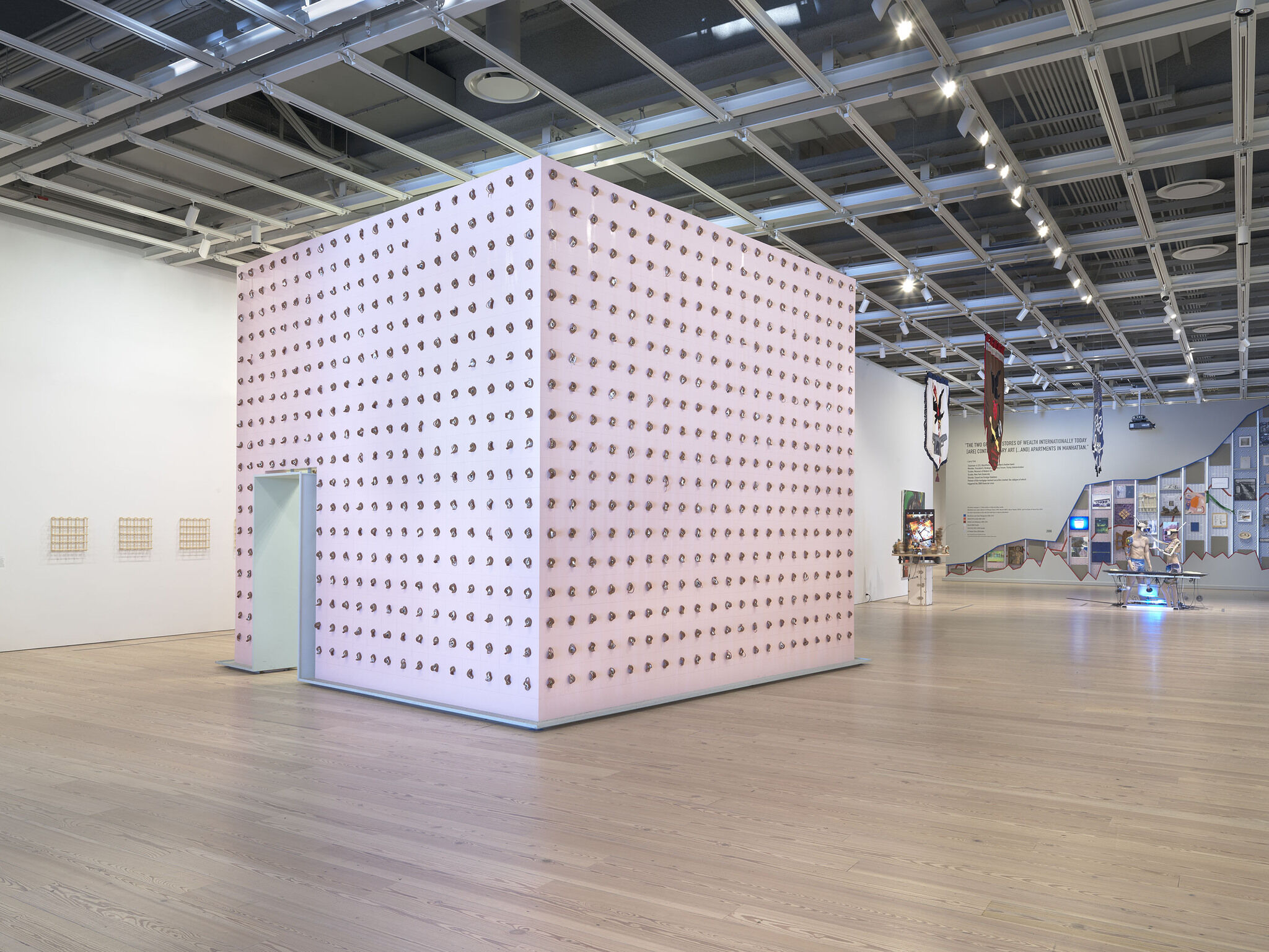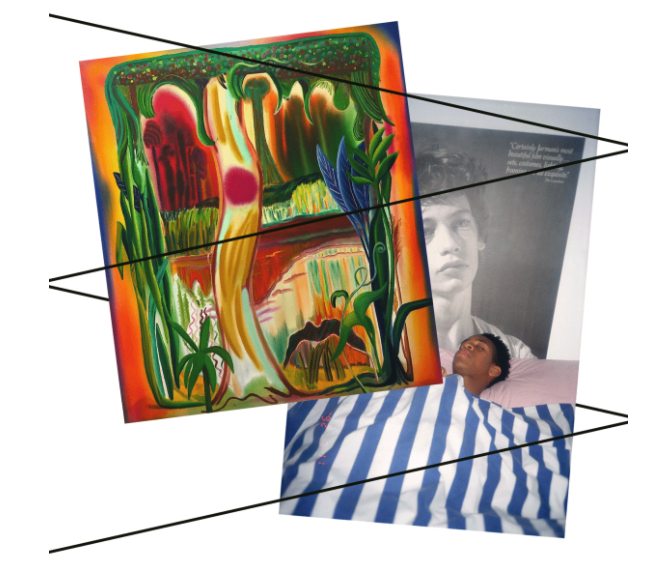Not on view
Date
2016
Classification
Sculpture
Medium
Aluminum, custom-printed fabric, mannequins, coral, driftwood, snorkels, foam fish, Bridget Riley exhibition catalogue, virtual-reality headsets, plastic, closed-circuit camera, iPhone, media player, analogue video switcher, video amplifier, microprocessor, lights, LCD screens, and motors
Dimensions
96 × 75 ½ × 63 in. (243.8 × 191.8 × 160 cm)
Accession number
2018.11
Credit line
Whitney Museum of American Art, New York; purchase, with funds from the Painting and Sculpture Committee
Rights and reproductions
© Jon Kessler
Audio
-
0:00
Jon Kessler
0:00
Jon Kessler: In Evolution these are well-to-do people who can mitigate the problem by building sea walls. Here there's a kind of a situation where they're surrounded by water. Water's up to their waist. The water is actually being created by a Bridget Riley painting that's being filmed live on video. And there's a certain amount of natural selection which has happened, and they've adapted to their environment. But they're also kind of oblivious to their environment. They're wearing VR goggles and they're not even really communicating with themselves or even aware.
Narrator: The woman in the sculpture is holding a model of a building designed by the late architect Zaha Hadid. It’s a luxury high rise that’s being built on the waterfront in Miami.
Jon Kessler: There's a weird situation where the countries that are the most responsible for the climate change are the ones who are building right on the coastlines and the ones who are sort of had nothing to blame, they have created no carbon emissions at all, they're the ones who are actually running from—so there's an incredible inequity which is present in the world right now. That piece is in some ways portraying that or highlighting that inequity.
-
Jon Kessler
In Whitney Biennial 2017 (Spanish)
0:00
Jon Kessler
0:00
Jon Kessler: En Evolution aparece gente adinerada que puede mitigar el problema al construir diques. La situación aquí es de gente que se encuentra rodeada por agua. El agua les llega a la cintura. Más aún, el agua se crea a partir de una pintura de Bridget Riley que se está filmando en video en tiempo real. En esta situación ha surgido una especie de selección natural y la gente se está adaptando a su medio. Pero, al mismo tiempo, es como si permaneciera inconsciente de su entorno. Los personajes llevan gafas de realidad virtual y no pueden comunicarse entre sí; no están conscientes siquiera.
Narrator: La mujer de la escultura sostiene la maqueta de un edificio diseñado por la difunta arquitecta Zaha Hadid. Es un rascacielos de lujo que se está construyendo en la costa de Miami.
Jon Kessler: Existe una especie de situación extraña en la cual los países con la mayor responsabilidad por el cambio climático son los mismos que construyen edificios en la costa. Y los países que, de alguna manera, no tienen culpa alguna, que no han generado emisiones de carbono en absoluto, son los que, en la práctica, se ven obligados a huir… Por tanto, el nivel de injusticia en el mundo actual es increíble. Con esta pieza, he querido representar o dar énfasis a dicha injusticia.
-
Jon Kessler
In Whitney Biennial 2017 (Kids, Spanish)
0:00
Jon Kessler
0:00
Jon Kessler: Mi nombre es Jon Kessler. Estas son dos esculturas mecánicas de gran tamaño con componentes de video que retransmiten en directo. Se basan en una investigación sobre el cambio climático, que he estado realizando durante el último par de años.
Una de las piezas se llama Exodus y, de hecho, comencé a trabajarla durante la crisis de los refugiados sirios. Ya entonces pensaba en la inmensa cantidad de refugiados que abandonarían los países de baja altitud, como las Islas Salomón, las Seychelles y Bangladesh. Es decir, un fenómeno que haría que cualquiera de las crisis de refugiados que hemos presenciado en los últimos tres años pareciera insignificante.
En esta pieza tenemos una cámara que retransmite en tiempo real, enfocada sobre figuras que compré en Ebay. Todas las figuras llevan bolsos y mochilas, y cargan con sus pertenencias. Por ende, lo que vemos es una marcha sin fin. Después, lo que ocurre con el componente del video es que, como se retransmite en tiempo real y la cámara apunta hacia el monitor, se crea un sistema de retroalimentación de video que hace la imagen más compleja, la duplica. Por eso, hay tres o cuatro hileras de figuras, lo que lo asemeja más con un éxodo masivo.
-
Jon Kessler
In Whitney Biennial 2017 (Kids)
0:00
Jon Kessler
0:00
Jon Kessler: My name is Jon Kessler. These are two large, mechanical sculptures that have video components, live video components. They're based on research I've been doing the last couple years about climate change.
One of them is called Exodus, and I started making that actually during the Syrian refugee crisis. And I was already thinking about the enormous amount of refugees that are going to be exiting from low-lying countries—the Solomon Islands, the Seychelles, Bangladesh. I mean, it's going to make any of the refugee crises we've seen in the last three years look like nothing.
In this piece what you've got is a live camera trained on figurines that I've gotten all on Ebay. But they're all figures with bags, and backpacks, and carrying their belongings. And so it's this endless march. And then what happens with the video component, because it's live video and because the camera is facing the monitor, it's a video feedback system so that it's actually complicating the image and it duplicates it. So it has, in a sense, three or four rows of figures making it look like even more of a mass exodus.
Exhibitions
Installation photography
-


Jon Kessler. Installation view. Evolution, 2016. Mixed media with motors, surveillance camera, iPhone, and LCD screens, 96 × 75 1/2 × 63 in. (243.8 × 191.8 × 160 cm). Collection of the artist; courtesy the artist and Salon 94, New York. Whitney Museum of American Art, New York, N.Y. Photograph by Bill Orcutt
From the exhibition Whitney Biennial 2017
-


Installation view of the Whitney Biennial 2017 (Whitney Museum of American Art, New York, March 17, 2017–June 11, 2017). From left to right: Ulrike Muller, Rug (gato chico), 2015; Occupy Museums, Debtfair, 2017; Harold Mendez, but I sound better since you cut my throat, 2016; Julien Nguyen, Executive Function, 2017; Julien Nguyen, Executive Solutions, 2017; Harold Mendez, At night we walk in circles, 2016; Jon Kessler, Evolution, 2016; Cauleen Smith, In the Wake, 2017; Pope L. aka William Pope.L, Claim (Whitney Version), 2017; Otto Gillen, New York, 2015; Dana Schultz, Elevator, 2017
From the exhibition Whitney Biennial 2017
-


Installation view of the Whitney Biennial 2017 (Whitney Museum of American Art, New York, March 17, 2017–June 11, 2017). From left to right: Matt Browning, Untitled, 2016; Matt Browning, Untitled, 2016; Matt Browning, Untitled, 2016; Pope.L aka William Pope.L, Claim (Whitney Version), 2017; Cauleen Smith, In the Wake, 2017; Jon Kessler, Exodus, 2016; Occupy Museums, Debtfair, 2017; Jon Kessler, Evolution, 2016
From the exhibition Whitney Biennial 2017

